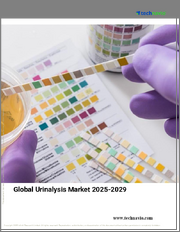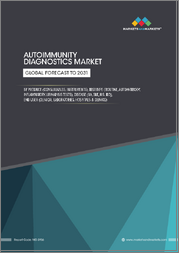
|
시장보고서
상품코드
1654411
소변 검사 시장 : 시장 규모, 점유율, 동향 분석 보고서 - 제품별, 용도별, 최종 용도별, 지역별, 부문별 예측(2025-2030년)Urinalysis Market Size, Share & Trends Analysis Report By Product (Instruments, Consumables), By Application (UTI Screening, Diabetes), By End Use (Hospitals, Clinical Laboratories), By Region, And Segment Forecasts, 2025 - 2030 |
||||||
소변 검사 시장 성장 및 동향
Grand View Research, Inc.의 최신 보고서에 따르면 세계의 소변 검사 시장 규모는 2025년부터 2030년까지 CAGR 7.83%로 확대될 전망이며, 2030년에는 68억 5,000만 달러에 이를 전망입니다. 세계의 요로 결석 이환율 증가가 시장 성장에 기여한 SHEA지가 발표한 조사에 따르면, 2021년에는 소변검사의 약 60%-70%가 소화관(GU)과 관련된 증상이 없는 환자에게 실시되고 있습니다.
선진국과 신흥국 시장에서 노인 증가와 이에 따른 연령 관련 질환 증가는 소변 검사 시장의 성장에 긍정적인 영향을 미칠 것으로 예상됩니다. 세계보건기구(WHO)에 따르면 노인은 2020년 10억 명에서 2021년 14억 명으로 증가하고 있습니다. 노인의 만성 질환의 조기 진단과 관리는 빌리루빈, 케톤 신체, 포도당, 크레아티닌 등의 검사의 배합률 증가의 원인이 되었습니다. 이러한 검사는 소변 검사에 의해 수행되기 때문에 시장 성장의 원동력이 될 것으로 예상됩니다.
또한, 신장이나 간과 같은 이식 수술을 받는 환자는 요로 감염(UTI)을 피하기 위해 수술 전에 소변 검사를 받는 것이 좋습니다. United Network for Organ Sharing의 데이터에 따르면, 미국에서는 2021년에 약 2만 4,669건의 신장 이식, 9,236건의 간 이식, 3,817건의 심장 이식이 이루어졌습니다. 따라서 이식 수술 증가는 시장 성장을 가속할 것으로 예상됩니다.
기업은 기술적으로 첨단 소변검사 제품 개발 및 판매를 위해 제휴 및 전략적 파트너십과 같은 이니셔티브를 취하고 있습니다. 예를 들어, 2021년 10월, Sysmex는 최고 수준의 자동 소변 검사 워크플로우 솔루션을 개발하기 위해 Inpeco와 협력을 시작했습니다. 이 제품은 Sysmex의 UN 시리즈와 임페코 소변 검사 솔루션의 FlexLab TM 트럭의 도움으로 개발되었습니다. 이 제품은 실험실이 워크플로 지원을 최적화하고 최상의 환자 관리를 제공할 수 있도록 지원하는 유일한 완전 개방형 자동화 시스템입니다.
소변 검사 시장 보고서 하이라이트
- 2024년 매출에서 소모품 부문은 78.56%로 압도적인 수익 점유율을 차지했습니다. 이러한 이점은 임상실과 병원실에서 시약 및 딥스틱 수요 증가와 빈번한 구매로 인한 것입니다.
- 요로 감염 스크리닝 부문은 시장을 독점했으며 2024년에는 24.07%의 수익 점유율을 차지했습니다.
- 임상 검사 부서는 2024년에 약 45.88%의 가장 높은 수익 점유율을 차지했습니다. 이는 환자에게 쉽게 접근할 수 있으며 이러한 실험실에서 고급 제품을 사용할 수 있기 때문입니다.
- 북미의 소변 검사 시장은 시장을 독점했으며 2024년에는 37.9%의 최대 수익 점유율을 차지했습니다.
목차
제1장 조사 방법 및 범위
제2장 주요 요약
제3장 소변 검사 시장의 변수, 동향 및 범위
- 시장 계통 전망
- 상위 시장 전망
- 관련 및 부수 시장 전망
- 시장 역학
- 시장 성장 촉진요인 분석
- 시장 성장 억제요인 분석
- 소변 검사 시장 분석 도구
- 산업 분석-Porter's Five Forces 분석
- PESTEL 분석
제4장 소변 검사 시장 : 제품별 추정 및 동향 분석
- 세계의 소변 검사 시장 : 제품별 대시보드
- 세계의 소변 검사 시장 : 제품별 변동 분석
- 세계의 소변 검사 시장 : 제품별 및 수익별
- 기기
- 생화학뇨 분석 장치
- 자동 생화학 분석 장치
- 반자동 요 침전물 분석 장치
- 자동뇨 침전물 분석 장치
- 현미경 소변 분석 장치
- 유동세포계측 소변 분석 장치
- 소모품
- 딥 스틱
- 시약
- 일회용
제5장 소변 검사 시장 : 용도별 추정 및 동향 분석
- 세계의 소변 검사 시장 : 용도별 대시보드
- 세계의 소변 검사 시장 : 용도별 변동 분석
- 세계의 소변 검사 시장 : 용도별 및 수익별
- 요로 감염
- 당뇨병
- 신장병
- 고혈압
- 간병
- 기타
제6장 소변 검사 시장 : 최종 용도별 추정 및 동향 분석
- 세계의 소변 검사 시장 : 최종 용도별 대시보드
- 세계의 소변 검사 시장 : 최종 용도별 변동 분석
- 세계의 소변 검사 시장 : 최종 용도별 및 수익별
- 병원
- 임상 검사
- 재택치료
- 연구 및 학술
- 기타
제7장 소변 검사 시장 : 제품, 용도, 최종 용도에 의한 지역별 추정 및 동향 분석
- 지역별 대시보드
- 시장 규모 및 예측 동향 분석(2018-2030년)
- 북미
- 미국
- 캐나다
- 멕시코
- 유럽
- 영국
- 독일
- 프랑스
- 이탈리아
- 스페인
- 노르웨이
- 스웨덴
- 덴마크
- 아시아태평양
- 일본
- 중국
- 인도
- 호주
- 한국
- 태국
- 라틴아메리카
- 브라질
- 아르헨티나
- 중동 및 아프리카
- 남아프리카
- 사우디아라비아
- 아랍에미리트(UAE)
- 쿠웨이트
제8장 경쟁 구도
- 주요 시장 진출기업에 의한 최근 동향 및 영향 분석
- 기업 및 경쟁의 분류
- 벤더 상황
- 주요 리셀러 및 채널 파트너 목록
- 주요 기업의 시장 점유율 분석(2024년)
- Abbott
- Sysmex Corporation
- Siemens Healthineers AG
- ACON Laboratories, Inc.
- ARKRAY Inc.
- Shenzhen Mindray Bio-Medical Electronics Co., Ltd.
- F. Hoffmann-La Roche Ltd.
- Quidel Corporation
- Bio-Rad Laboratories, Inc.
Urinalysis Market Growth & Trends:
The global urinalysis market size is expected to reach USD 6.85 billion by 2030, expanding at a CAGR of 7.83% from 2025 to 2030, according to a new report by Grand View Research, Inc. Increasing incidence of UTI worldwide contributes to market growth. According to a study published by SHEA journal, in 2021, approximately 60% to 70% of urinalyses were being performed in patients without symptoms referable to the Gastrointestinal Tract (GU).
Increasing geriatric population and the subsequent increase in age related diseases in developed and developing regions will positively influence urinalysis market growth. According to the World Health Organization (WHO), the geriatric population increased from 1 billion in 2020 to 1.4 billion in 2021. The early diagnosis and management of chronic diseases in geriatric population is responsible for the increasing prescription rate for tests such as bilirubin, ketones, glucose, and creatinine. These tests are performed by urinalysis; hence, it is anticipated to drive market growth.
Moreover, for patients undergoing transplant surgeries including kidney and liver, transplant procedures is often recommended to undergo preoperative urinalysis to avoid urinary tract infections (UTIs). According to United Network for Organ Sharing data, around 24,669 kidney transplants, 9,236 liver transplants, and 3,817 heart transplants were performed in the U.S. in 2021. Thus, an increasing number of transplant surgeries is expected to fuel market growth.
Companies are taking initiatives such as collaboration and strategic partnerships for the development and marketing of technologically advanced urinalysis products. For instance, in October 2021, Sysmex entered into collaboration with Inpeco for the development of an automated urinalysis workflow solution of the highest level. This product was developed with a help of UN-Series of Sysmex's and FlexLab TM track of Inpeco's urinalysis solutions. It is the only fully open automation system that helps laboratories optimize their workflow support and provide premium patient care.
Urinalysis Market Report Highlights:
- The consumables segment held the dominant revenue share of 78.56% in terms of revenue in 2024. This dominance can be attributed to the increasing demand and frequent purchases of reagents and dipsticks by clinical and hospital laboratories.
- The urinary tract infection screening segment dominated the market and accounted for a revenue share of 24.07% in 2024, due to the rising incidence of UTIs worldwide.
- The clinical laboratories segment accounted for the highest revenue share of around 45.88% in 2024. This can be attributed to their easy accessibility to patients and the availability of advanced products in these laboratories.
- North America urinalysis market dominated the market and accounted for the largest revenue share of 37.9% in 2024.
Table of Contents
Chapter 1. Methodology and Scope
- 1.1. Market Segmentation & Scope
- 1.2. Segment Definitions
- 1.2.1. Product
- 1.2.2. Application
- 1.2.3. End Use
- 1.2.4. Regional scope
- 1.2.5. Estimates and forecasts timeline
- 1.3. Research Methodology
- 1.4. Information Procurement
- 1.4.1. Purchased database
- 1.4.2. GVR's internal database
- 1.4.3. Secondary sources
- 1.4.4. Primary research
- 1.4.5. Details of primary research
- 1.4.5.1. Data for primary interviews in North America
- 1.4.5.2. Data for primary interviews in Europe
- 1.4.5.3. Data for primary interviews in Asia Pacific
- 1.4.5.4. Data for primary interviews in Latin America
- 1.4.5.5. Data for Primary interviews in MEA
- 1.5. Information or Data Analysis
- 1.5.1. Data analysis models
- 1.6. Market Formulation & Validation
- 1.7. Model Details
- 1.7.1. Commodity flow analysis (Model 1)
- 1.7.2. Approach 1: Commodity flow approach
- 1.7.3. Volume price analysis (Model 2)
- 1.7.4. Approach 2: Volume price analysis
- 1.8. List of Secondary Sources
- 1.9. List of Primary Sources
- 1.10. Objectives
Chapter 2. Executive Summary
- 2.1. Market Outlook
- 2.2. Segment Outlook
- 2.2.1. Product, application and end-use outlook
- 2.2.2. Regional outlook
- 2.3. Competitive Insights
Chapter 3. Urinalysis Market Variables, Trends & Scope
- 3.1. Market Lineage Outlook
- 3.1.1. Parent market outlook
- 3.1.2. Related/ancillary market outlook
- 3.2. Market Dynamics
- 3.2.1. Market driver analysis
- 3.2.1.1. Increasing prevalence of chronic and infectious diseases
- 3.2.1.2. Technological advancements in urinalysis devices
- 3.2.1.3. Rising geriatric population
- 3.2.2. Market restraint analysis
- 3.2.2.1. High cost of advanced urinalysis equipment
- 3.2.1. Market driver analysis
- 3.3. Urinalysis Market Analysis Tools
- 3.3.1. Industry Analysis - Porter's
- 3.3.1.1. Supplier power
- 3.3.1.2. Buyer power
- 3.3.1.3. Substitution threat
- 3.3.1.4. Threat of new entrant
- 3.3.1.5. Competitive rivalry
- 3.3.2. PESTEL Analysis
- 3.3.2.1. Political landscape
- 3.3.2.2. Economic landscape
- 3.3.2.3. Technological landscape
- 3.3.2.4. Social landscape
- 3.3.2.5. Environmental landscape
- 3.3.1. Industry Analysis - Porter's
Chapter 4. Urinalysis Market: Product Estimates & Trend Analysis
- 4.1. Global Urinalysis Market: Product Dashboard
- 4.2. Global Urinalysis Market: Product Movement Analysis
- 4.3. Global Urinalysis Market by Product , Revenue
- 4.4. Instruments
- 4.5. Biochemical Urine Analyzer
- 4.5.1. Biochemical urine analyzer market estimates and forecasts 2018 to 2030 (USD Billion)
- 4.5.2. Automated Biochemical Analyzers
- 4.5.2.1. Automated biochemical analyzers market estimates and forecasts 2018 to 2030 (USD Billion)
- 4.5.3. Semi-automated Urine Sediment Analyzers
- 4.5.3.1. Semi-automated urine sediment analyzers market estimates and forecasts 2018 to 2030 (USD Billion)
- 4.6. Automated Urine Sediment Analyzers
- 4.6.1. Automated urine sediment analyzers market estimates and forecasts 2018 to 2030 (USD Billion)
- 4.6.2. Microscopic Urine Analyzers
- 4.6.2.1. Microscopic urine analyzers market estimates and forecasts 2018 to 2030 (USD Billion)
- 4.6.3. Flowcytometric Urine Analyzers
- 4.6.3.1. Flowcytometric urine analyzers market estimates and forecasts 2018 to 2030 (USD Billion)
- 4.7. Consumables
- 4.8. Dipsticks
- 4.8.1. Dipsticks market estimates and forecasts 2018 to 2030 (USD Billion)
- 4.9. Reagents
- 4.9.1. Reagents market estimates and forecasts 2018 to 2030 (USD Billion)
- 4.10. Disposables
- 4.10.1. Disposables market estimates and forecasts 2018 to 2030 (USD Billion)
Chapter 5. Urinalysis Market: Application Estimates & Trend Analysis
- 5.1. Global Urinalysis Market: Application Dashboard
- 5.2. Global Urinalysis Market: Application Movement Analysis
- 5.3. Global Urinalysis Market by Application , Revenue
- 5.4. UTI Screening
- 5.4.1. UTI screening market estimates and forecasts 2018 to 2030 (USD Billion)
- 5.5. Diabetes
- 5.5.1. Diabetes market estimates and forecasts 2018 to 2030 (USD Billion)
- 5.6. Kidney Disease
- 5.6.1. Kidney disease market estimates and forecasts 2018 to 2030 (USD Billion)
- 5.7. Hypertension
- 5.7.1. Hypertension market estimates and forecasts 2018 to 2030 (USD Billion)
- 5.8. Liver Disease
- 5.8.1. Liver disease market estimates and forecasts 2018 to 2030 (USD Billion)
- 5.9. Others
- 5.9.1. Others market estimates and forecasts 2018 to 2030 (USD Billion)
Chapter 6. Urinalysis Market: End Use Estimates & Trend Analysis
- 6.1. Global Urinalysis Market: End Use Dashboard
- 6.2. Global Urinalysis Market: End Use Movement Analysis
- 6.3. Global Urinalysis Market by End Use, Revenue
- 6.4. Hospitals
- 6.4.1. Hospitals market estimates and forecasts 2018 to 2030 (USD Billion)
- 6.5. Clinical Laboratories
- 6.5.1. Clinical laboratories market estimates and forecasts 2018 to 2030 (USD Billion)
- 6.6. Home Care
- 6.6.1. Home care market estimates and forecasts 2018 to 2030 (USD Billion)
- 6.7. Research and Academics
- 6.7.1. Research and academics market estimates and forecasts 2018 to 2030 (USD Billion)
- 6.8. Others
- 6.8.1. Others market estimates and forecasts 2018 to 2030 (USD Billion)
Chapter 7. Urinalysis Market: Regional Estimates & Trend Analysis by Product, Application, and End Use
- 7.1. Regional Dashboard
- 7.2. Market Size, & Forecasts Trend Analysis, 2018 to 2030:
- 7.3. North America
- 7.3.1. U.S.
- 7.3.1.1. Key country dynamics
- 7.3.1.2. Regulatory framework/ reimbursement structure
- 7.3.1.3. Competitive scenario
- 7.3.1.4. U.S. market estimates and forecasts 2018 to 2030 (USD Billion)
- 7.3.2. Canada
- 7.3.2.1. Key country dynamics
- 7.3.2.2. Regulatory framework/ reimbursement structure
- 7.3.2.3. Competitive scenario
- 7.3.2.4. Canada market estimates and forecasts 2018 to 2030 (USD Billion)
- 7.3.3. Mexico
- 7.3.3.1. Key country dynamics
- 7.3.3.2. Regulatory framework/ reimbursement structure
- 7.3.3.3. Competitive scenario
- 7.3.3.4. Mexico market estimates and forecasts 2018 to 2030 (USD Billion)
- 7.3.1. U.S.
- 7.4. Europe
- 7.4.1. UK
- 7.4.1.1. Key country dynamics
- 7.4.1.2. Regulatory framework/ reimbursement structure
- 7.4.1.3. Competitive scenario
- 7.4.1.4. UK market estimates and forecasts 2018 to 2030 (USD Billion)
- 7.4.2. Germany
- 7.4.2.1. Key country dynamics
- 7.4.2.2. Regulatory framework/ reimbursement structure
- 7.4.2.3. Competitive scenario
- 7.4.2.4. Germany market estimates and forecasts 2018 to 2030 (USD Billion)
- 7.4.3. France
- 7.4.3.1. Key country dynamics
- 7.4.3.2. Regulatory framework/ reimbursement structure
- 7.4.3.3. Competitive scenario
- 7.4.3.4. France market estimates and forecasts 2018 to 2030 (USD Billion)
- 7.4.4. Italy
- 7.4.4.1. Key country dynamics
- 7.4.4.2. Regulatory framework/ reimbursement structure
- 7.4.4.3. Competitive scenario
- 7.4.4.4. Italy market estimates and forecasts 2018 to 2030 (USD Billion)
- 7.4.5. Spain
- 7.4.5.1. Key country dynamics
- 7.4.5.2. Regulatory framework/ reimbursement structure
- 7.4.5.3. Competitive scenario
- 7.4.5.4. Spain market estimates and forecasts 2018 to 2030 (USD Billion)
- 7.4.6. Norway
- 7.4.6.1. Key country dynamics
- 7.4.6.2. Regulatory framework/ reimbursement structure
- 7.4.6.3. Competitive scenario
- 7.4.6.4. Norway market estimates and forecasts 2018 to 2030 (USD Billion)
- 7.4.7. Sweden
- 7.4.7.1. Key country dynamics
- 7.4.7.2. Regulatory framework/ reimbursement structure
- 7.4.7.3. Competitive scenario
- 7.4.7.4. Sweden market estimates and forecasts 2018 to 2030 (USD Billion)
- 7.4.8. Denmark
- 7.4.8.1. Key country dynamics
- 7.4.8.2. Regulatory framework/ reimbursement structure
- 7.4.8.3. Competitive scenario
- 7.4.8.4. Denmark market estimates and forecasts 2018 to 2030 (USD Billion)
- 7.4.1. UK
- 7.5. Asia Pacific
- 7.5.1. Japan
- 7.5.1.1. Key country dynamics
- 7.5.1.2. Regulatory framework/ reimbursement structure
- 7.5.1.3. Competitive scenario
- 7.5.1.4. Japan market estimates and forecasts 2018 to 2030 (USD Billion)
- 7.5.2. China
- 7.5.2.1. Key country dynamics
- 7.5.2.2. Regulatory framework/ reimbursement structure
- 7.5.2.3. Competitive scenario
- 7.5.2.4. China market estimates and forecasts 2018 to 2030 (USD Billion)
- 7.5.3. India
- 7.5.3.1. Key country dynamics
- 7.5.3.2. Regulatory framework/ reimbursement structure
- 7.5.3.3. Competitive scenario
- 7.5.3.4. India market estimates and forecasts 2018 to 2030 (USD Billion)
- 7.5.4. Australia
- 7.5.4.1. Key country dynamics
- 7.5.4.2. Regulatory framework/ reimbursement structure
- 7.5.4.3. Competitive scenario
- 7.5.4.4. Australia market estimates and forecasts 2018 to 2030 (USD Billion)
- 7.5.5. South Korea
- 7.5.5.1. Key country dynamics
- 7.5.5.2. Regulatory framework/ reimbursement structure
- 7.5.5.3. Competitive scenario
- 7.5.5.4. South Korea market estimates and forecasts 2018 to 2030 (USD Billion)
- 7.5.6. Thailand
- 7.5.6.1. Key country dynamics
- 7.5.6.2. Regulatory framework/ reimbursement structure
- 7.5.6.3. Competitive scenario
- 7.5.6.4. Thailand market estimates and forecasts 2018 to 2030 (USD Billion)
- 7.5.1. Japan
- 7.6. Latin America
- 7.6.1. Brazil
- 7.6.1.1. Key country dynamics
- 7.6.1.2. Regulatory framework/ reimbursement structure
- 7.6.1.3. Competitive scenario
- 7.6.1.4. Brazil market estimates and forecasts 2018 to 2030 (USD Billion)
- 7.6.2. Argentina
- 7.6.2.1. Key country dynamics
- 7.6.2.2. Regulatory framework/ reimbursement structure
- 7.6.2.3. Competitive scenario
- 7.6.2.4. Argentina market estimates and forecasts 2018 to 2030 (USD Billion)
- 7.6.1. Brazil
- 7.7. MEA
- 7.7.1. South Africa
- 7.7.1.1. Key country dynamics
- 7.7.1.2. Regulatory framework/ reimbursement structure
- 7.7.1.3. Competitive scenario
- 7.7.1.4. South Africa market estimates and forecasts 2018 to 2030 (USD Billion)
- 7.7.2. Saudi Arabia
- 7.7.2.1. Key country dynamics
- 7.7.2.2. Regulatory framework/ reimbursement structure
- 7.7.2.3. Competitive scenario
- 7.7.2.4. Saudi Arabia market estimates and forecasts 2018 to 2030 (USD Billion)
- 7.7.3. UAE
- 7.7.3.1. Key country dynamics
- 7.7.3.2. Regulatory framework/ reimbursement structure
- 7.7.3.3. Competitive scenario
- 7.7.3.4. UAE market estimates and forecasts 2018 to 2030 (USD Billion)
- 7.7.4. Kuwait
- 7.7.4.1. Key country dynamics
- 7.7.4.2. Regulatory framework/ reimbursement structure
- 7.7.4.3. Competitive scenario
- 7.7.4.4. Kuwait market estimates and forecasts 2018 to 2030 (USD Billion)
- 7.7.1. South Africa
Chapter 8. Competitive Landscape
- 8.1. Recent Developments & Impact Analysis, By Key Market Participants
- 8.2. Company/Competition Categorization
- 8.3. Vendor Landscape
- 8.3.1. List of key distributors and channel partners
- 8.3.2. Key customers
- 8.3.3. Key company market share analysis, 2024
- 8.3.4. Abbott
- 8.3.4.1. Company overview
- 8.3.4.2. Financial performance
- 8.3.4.3. Product benchmarking
- 8.3.4.4. Strategic initiatives
- 8.3.5. Sysmex Corporation
- 8.3.5.1. Company overview
- 8.3.5.2. Financial performance
- 8.3.5.3. Product benchmarking
- 8.3.5.4. Strategic initiatives
- 8.3.6. Siemens Healthineers AG
- 8.3.6.1. Company overview
- 8.3.6.2. Financial performance
- 8.3.6.3. Product benchmarking
- 8.3.6.4. Strategic initiatives
- 8.3.7. ACON Laboratories, Inc.
- 8.3.7.1. Company overview
- 8.3.7.2. Financial performance
- 8.3.7.3. Product benchmarking
- 8.3.7.4. Strategic initiatives
- 8.3.8. ARKRAY Inc.
- 8.3.8.1. Company overview
- 8.3.8.2. Financial performance
- 8.3.8.3. Product benchmarking
- 8.3.8.4. Strategic initiatives
- 8.3.9. Shenzhen Mindray Bio-Medical Electronics Co., Ltd.
- 8.3.9.1. Company overview
- 8.3.9.2. Financial performance
- 8.3.9.3. Product benchmarking
- 8.3.9.4. Strategic initiatives
- 8.3.10. F. Hoffmann-La Roche Ltd.
- 8.3.10.1. Company overview
- 8.3.10.2. Financial performance
- 8.3.10.3. Product benchmarking
- 8.3.10.4. Strategic initiatives
- 8.3.11. Quidel Corporation
- 8.3.11.1. Company overview
- 8.3.11.2. Financial performance
- 8.3.11.3. Product benchmarking
- 8.3.11.4. Strategic initiatives
- 8.3.12. Bio-Rad Laboratories, Inc.
- 8.3.12.1. Company overview
- 8.3.12.2. Financial performance
- 8.3.12.3. Product benchmarking
- 8.3.12.4. Strategic initiatives
(주말 및 공휴일 제외)


















